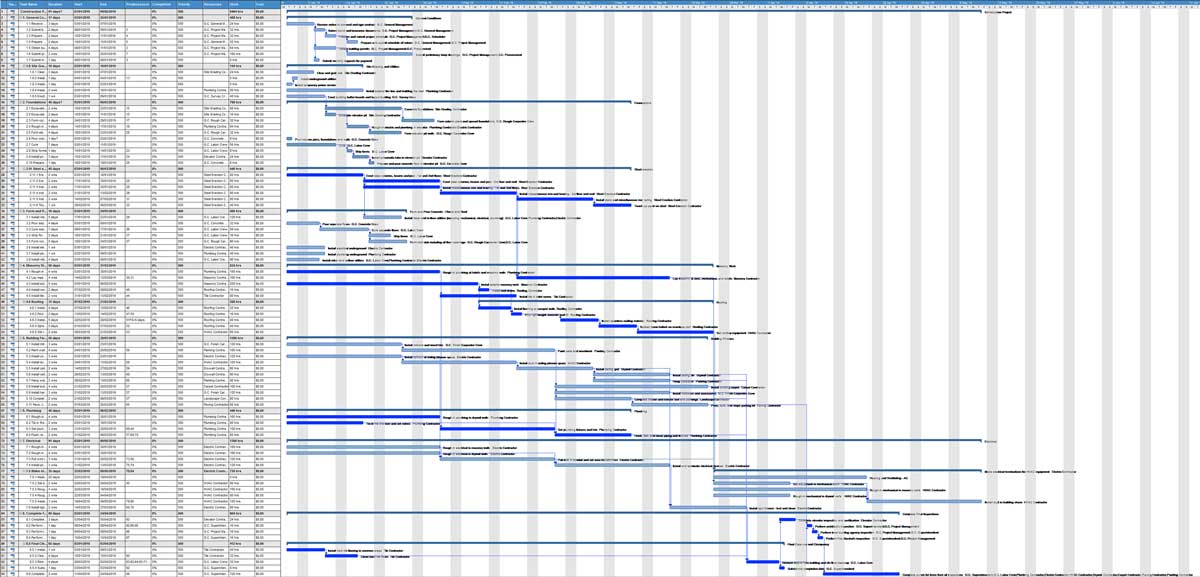Project management
Managing Residential Building Projects from start to finish
We will oversee the entire building project management process for both domestic and commercial clients, starting with designs that are tailored to ensure the planning application has the best chance of approval.
Following that we will crate the building reguilations drawings, put the works out to tender, manage the procurement of a contractor and oversee the subsequent programme management to ensure the works go smoothly once on site and the end product suits the clients needs and exceeds expectations.
A single Point of Contact
Managing a building project can take a huge amount of time, and if you've never done it before it is no simple task.
Hiring a professional project manager can save you time and money in the long run, not to mention the stress you can avoid by having a single point of contact for all your queries and requests.
Building Project management Fees
Our building project management strategy can be tailored to suit our client's requirements and as a result our fee structure is flexible and is therefore affordable for all budgets, feel free to contact us so that we can discuss your project and our fees in more detail.
Planning Drawings Kent
We can help you plan and design your New Build using our latest 3D Architectural Design Software.
This brings your project to life and helps you make the right design decisions for your project before you start the expensive build phase.
Planning Permission Kent
The process of acquiring planning permission can be a long one, so getting it right first time should be your aim.
The planning case officer will consider different factors of the application including drawings and comments from neighbours to see that the plans meet the planning guidelines and the approval of the council.
Building Regulations Kent
Building regulations are a legal requirement and must be met on every extension, alteration or development project. Once planning permission has been granted an application to building control must be made to ensure full compliance before work is commenced.
Example Single Storey Extension Project Plan
When adding an extension, the order of works will vary from project to project, but this planner will give you a good idea of what is involved.
There are also common mistakes to be avoided, so after we have outlined the order of works, you can read on to find out how to ensure your project is successful.
The schedule below is based on a single storey kitchen extension. It will give you a rough idea on project length and allow you to scale up, or down, accordingly. A two storey extension takes between three to five weeks longer than a single storey design. And, if you plan to live in the house while the work is carried out, things tend to take longer.
The Project Schedule
Week 1–2
Setting out, footings dug, and foundations poured
- Builders will arrive on site.
- If you are project managing, you may need to arrange digger hire, but your builders should do this for you.

Week 3–4
Building up to damp-proof course (DPC), drains installed, DPC installed and concrete oversite/floor structure put in place
- Ensure materials are ordered and delivered ready for the concrete floors to be poured, including insulation and any damp-proof membrane.
- In some cases, a drain run may require that a concrete lintel will need to be inserted into the brickwork at this stage.
- Sand will then be put down before the damp-proof membrane, insulation and the concrete slab is poured.
Week 5
Building of external walls
- It varies whether the brickwork or blocks are built first, but in both cases cavity wall insulation will be fitted at this point.
- Wall ties are used to fix the new walls to those in the existing house.

Week 6
Internal walls built
- It’s time to begin thinking about arranging delivery of items further down the line which can be on lead times of three to five weeks (e.g. windows, roof tiles).
Week 6–7
Roof structure built
- A carpenter will be brought in at this stage to build the roof structure. In the case of rooflights being fitted, they will also be in charge of this in most cases.
- Ensure the roofers know when they are needed — you want to get watertight as soon as possible.
- Check all materials are in place for the roofing, including lead.

Week 7
Roof Coverings
- Roofing membrane will be laid out over the rafters before roof battens are cut and fitted over — how they are spaced will depend on your roof covering of choice.

Week 8
Install windows and doors
- It is likely (and certainly preferable) that door linings and window frames will have been put in place while the external walls were built, so fitting windows and doors can now be carried out.

Week 9
First fix electrics and plumbing; carpentry
- Once the extension is watertight, electrics and plumbing can get underway. The two trades often have to work closely together, so ensure each knows what the other is doing to avoid delays.

Week 10
Break through from existing house, steels put in place, joins made good
- With the breaking through from the existing house, this is where things can get messy and, if you are still going to be living in the house, you should start sealing yourself off from the mess as much as possible.

Week 11
Plastering, followed by a period of drying out
- As a general rule, new plaster should be left for around a week before any decorating takes place.
- Be aware that plastering is a messy old job and that your plasterer will need a clear route to a water source (preferably not your bathroom…).

Week 12
Second fix, electrics, plumbing, flooring fitted, and kitchen units installed
- You really need to ensure all these processes can work together and that each trade knows who is doing what and when, as this is a stage when delays can occur.

Week 14
Snagging
- Any leaks, problems with electrics and sticking doors and windows need to be reported to the relevant trade as soon as possible after finishing.




